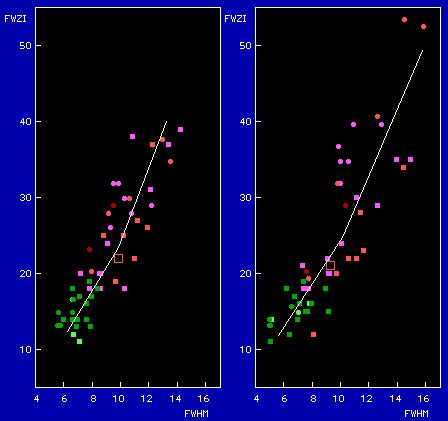Definition of the primary companion spectral type
and luminosity class for CI Cam.
The spectrum of the primary companion in the CI Cam system
is distorted and hided by the surrounding dusty and gaseous
shell. For the first time, the absorption detailes of
this companion were discovered in the lines of
H-delta and H-epsilon by Hynes R.I., Clark J.S.,
Barsukova E.A., et al. (Astron. & Astrophys.
V.392, 991, 2002). These are wide wings due to Stark
effect in the star photosphere. In our spectrum taken
with BTA in the blue region, it is well seen that the
emission component of the shell decreases rapidly
in the line profile as
the number of Balmer line increases, and the wide
absorption profiles loom. The width of hydrogen lines
is known to depend on the pressure in the photosphere,
and then on the luminosity and effective temperature
of the star. We have studied this dependence using
the spectra of normal B stars from the databases
by Jacoby et al., ApJ Suppl V.56, p.257, 1984,
and
Toulouse-Tarbe Laboratory. The resolution of
Jacoby spectra (4.5á) coincides with the resolution
of our BTA/UAGS spectra (4.4A). But Toulouse-Tarbe
spectra had higher resolution (2.9á), so the parameters
estimated by this database were recalculated to our resolution.
We choose H-delta (4101.74 A) and H-eta (3835.39 A) lines
for the analysis, as their profiles in CI Cam were
distorted by emissions least of all.

Dependence of full width FWZI of hydrogen lines
on star spectral type and luminosity class. Green
signs show I-II luminosity class, red signs of
different tints - III-V class. Filled squars
are the data from Jacoby database, circles are
the modified data from Toulouse-Tarbe database.
The location of check star, HD 52918 (B1V) is marked
by open square, its spectrum was taken with BTA
at the same night as CI Cam one. It is seen that CI Cam
is located far out of the supergiants' region
(class I-II).
FWZI is equal to 25A for CI Cam for the both lines.
This means that the star undoubtly belongs to
B4 III-V type.
Full width of lines depends on adopted continuum level
and is estimated with
the uncertainty of about 2-3A, so, check of these
estimates is needed. Therefore, we measured correctly
the half-width of these lines (FWHM) using the
CENTER/GAUSS method of the MIDAS packet. Unfortunately,
this method is unavailable to CI Cam because
the central parts of the profile are distorted by
the emission. The dependences between FWZI and
FWHM for the normal B stars of the two databases
are shown in the following Figure. Note that
Toulouse-Tarbe data were again recalculated to
lower resolution assuming that the profiles have
the shape close to Gaussians. Clear connection
between FWZI and FWHM is a reason to consider
our estimates of spectral type and luminosity as reliable.

Dependence between measured half-width and
estimated full width of selected hydrogen lines H-eta and
H-delta. Designation is the same as in the
previous Figure.


